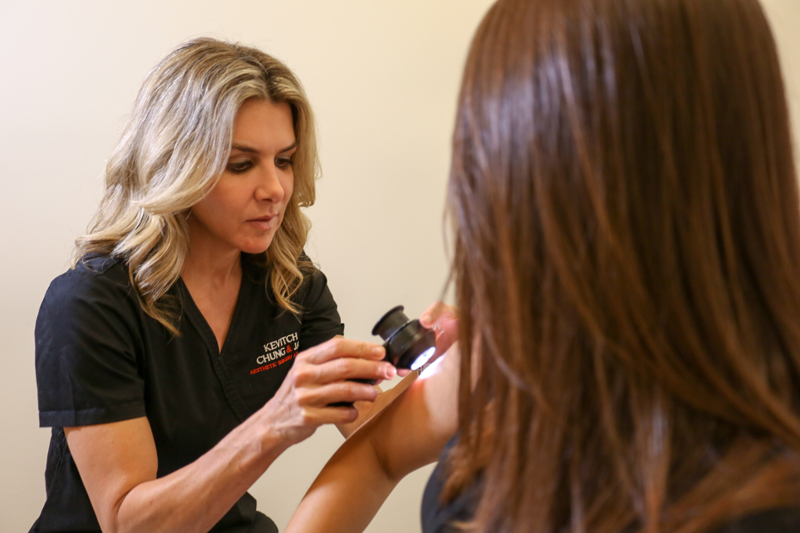Skin Cancer
Schedule a ConsultationBasal Cell Skin Cancer
This is the most common type of skin cancer. Basal cell skin cancers are most common in areas of the body that are collected the most sun (UV) exposure over the years, like the head and neck, and thus, are thought to be directly related to the amount of sun exposure a person collects. These types of skin cancers are generally very slow-growing. Basal cell skin cancers often start as a pearly pink bump on the skin that, over many years, slowly grows locally and can eventually ulcerate and bleed. If left untreated, this type of skin cancer can start to invade local structures and, rarely, metastasize. This type of skin cancer is almost always curable.
How are basal cell skin cancers treated? There are several different options depending on the location, subtype, size, and health of the individual being treated. Treatment options may include: excision (under local anesthesia), excision with frozen sections (performed in a hospital or same-day surgery center under sedation), Mohs surgery (performed by a specialized surgeon under local anesthesia), curettage and electrodesiccation (under local anesthesia), radiation therapy, topical fluorouracil or imiquimod treatment (for limited superficial cases), and Erivedge (for extensive cases, prescribed by an Oncologist).

Squamous Cell Skin Cancer
This is the second most common type of skin cancer. This type of skin cancer is also most common in the more sun-exposed areas of the head and neck, but can also develop in the mouth. This type of skin cancer is also caused by sun (UV) exposure as well as other damaging agents and exposures. Squamous cell skin cancers grow faster and can be more likely to invade local structures and metastasize than basal cell skin cancers. They can manifest as a red scaling area, open sores, or thick crusted or scaling areas that can be sensitive and never seems to heal. This type of skin cancer can generally be cured with treatment.
How are squamous cell skin cancers treated? There are several different options depending on the location, subtype, size, and health of the individual being treated. Treatment options may include: excision (under local anesthesia), excision with frozen sections (performed in a hospital or same-day surgery center under sedation), Mohs surgery (performed by a specialized surgeon under local anesthesia), curettage and electrodesiccation (under local anesthesia), radiation therapy, topical fluorouracil or imiquimod treatment (for limited superficial cases), and Erivedge (for extensive cases, prescribed by an Oncologist).
Malignant Melanoma
This is the third most common type of skin cancer and the fastest growing and most potentially deadly of the three types. This type of skin cancer can develop from sun (UV) exposure OR from a genetic predisposition. Unlike basal and squamous cell skin cancers, this type of cancer develops in melanocytes (the cells that give your skin pigment). Melanoma may develop in an existing mole or de novo (completely new pigmented area that was never there before). To detect melanoma, we typically educate patients on the ABCDEs: Asymmetry, Border irregularity, Color variation, Diameter larger than the size of a pencil eraser (>5mm), Evolving (changes in size, shape, color, etc). Melanoma is generally dark brown/black in color but can be a pink or colorless lesion, making it even more difficult to detect. Melanoma can be flat or raised!
When melanoma is found, how is it treated? Treatment options may include excision (under local anesthesia or performed in a hospital or same-day surgery center under sedation), or slow Mohs surgery (performed by a specialized surgeon under local anesthesia). Depending on the extent of the melanoma, it may be necessary to involve an Oncologist for removal and testing of lymph node(s), chemotherapy, and/or immunotherapy.
What are the survival rates for Melanoma? According to the Skin Cancer Foundation, the estimated five-year survival rate for patients whose melanoma is detected early is about 98%. The survival rate falls to 64% when the disease reaches the lymph nodes and 23% when the disease metastasizes to distant organs.
How can you be proactive about early detection? Look over your skin monthly to assess for any changes in your existing moles and be vigilant of any new suspicious lesions. And, GET YOUR ANNUAL SKIN EXAMS IN A DERMATOLOGY OFFICE! Here at our Dermatology office, we have highly trained professionals to help keep your skin happy and healthy!
